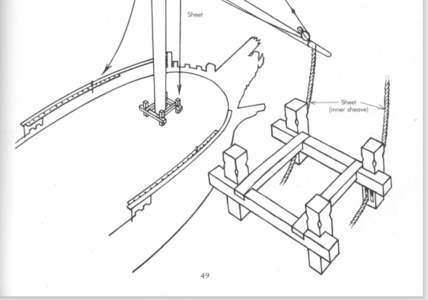This is a question about where to find information. This is just one example of what I feel I'm running into. I'm building the quarterdeck breastworks. Each stanchion has two sheaves at it's base. What I'm wondering about is how do I find out what rigging goes through those sheaves. I have "Rigging Period Models" Steel's Rigging treatise(can't remember the name) and for the life of me I can't find a picture or text showing any rigging going through those sheaves. I'm sure that once I know what that bit of rigging is called I will be able to find a bunch of stuff about it but this is kind of a "Catch 22". I don't know what it's called so I can't look it up to find out what it's called. I need something that will kind of open a door through the initial confusion. Right now it's just a huge blank wall. Can anyone identify a source or method that may help me break into this. I'm not actually rigging yet but it's looming up and it's starting to wear on me. Thanks
You are using an out of date browser. It may not display this or other websites correctly.
You should upgrade or use an alternative browser.
You should upgrade or use an alternative browser.
- Joined
- Aug 8, 2019
- Messages
- 4,129
- Points
- 688

You can try these 2 books, they helped me a lot.
The Rigging of Ships in the Days of the Spritsail Topmast, 1600-1720 by R.C. Anderson
Anderson was an inspiration to a lot of writers like this book of Leest
The Masting and Rigging of English Ships of War, 1625-1860 by James leest
The Rigging of Ships in the Days of the Spritsail Topmast, 1600-1720 by R.C. Anderson
Anderson was an inspiration to a lot of writers like this book of Leest
The Masting and Rigging of English Ships of War, 1625-1860 by James leest
Anderson's book is in my price range but I'm wondering about the date/period. It goes up to 1720 and my Discovery is 1789. Would it still be of some value? I've bought some books that I have got virtually no information from so I'm a bit gunshy..
- Joined
- Oct 17, 2020
- Messages
- 1,336
- Points
- 393

Don Caso, sorry could you post some pictures? To understand meAnderson's book is in my price range but I'm wondering about the date/period. It goes up to 1720 and my Discovery is 1789. Would it still be of some value? I've bought some books that I have got virtually no information from so I'm a bit gunshy..
- Joined
- Aug 8, 2019
- Messages
- 4,129
- Points
- 688

The most things that changed after that period are not so much. The principe keeps the same without spritsail.Anderson's book is in my price range but I'm wondering about the date/period. It goes up to 1720 and my Discovery is 1789. Would it still be of some value? I've bought some books that I have got virtually no information from so I'm a bit gunshy..
Hi Frank, good to see you back. Right where the arrow points there will be holes to take the place of the sheaves (they were too small for me to make). What I'm looking for is a book or something to tell me what rigging goes there. Hope that helps. And I hope my gibberish makes it through google translateDon Caso, sorry could you post some pictures? To understand me
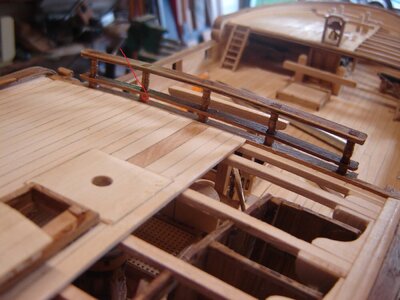
Last edited:
Rigging Period Ship Models by Lennarth Petersson that may have the information you are looking for.This is a question about where to find information. This is just one example of what I feel I'm running into. I'm building the quarterdeck breastworks. Each stanchion has two sheaves at it's base. What I'm wondering about is how do I find out what rigging goes through those sheaves. I have "Rigging Period Models" Steel's Rigging treatise(can't remember the name) and for the life of me I can't find a picture or text showing any rigging going through those sheaves. I'm sure that once I know what that bit of rigging is called I will be able to find a bunch of stuff about it but this is kind of a "Catch 22". I don't know what it's called so I can't look it up to find out what it's called. I need something that will kind of open a door through the initial confusion. Right now it's just a huge blank wall. Can anyone identify a source or method that may help me break into this. I'm not actually rigging yet but it's looming up and it's starting to wear on me. Thanks
I have Petersons book, that's the one with all pictures, right? I looked and looked through it and couldn't see anything that looked right.
You may try Lennarth Petersson's book. It's centered directly on your time period. Although the rigging is not specific to the English frigate HMS Melampus launched in 1785, it is a great guide for general rigging, and it does this all with pictures, so it's easy to follow. He has a similar book for fore-aft rigged sailing ships too. It's on Amazon HERE for $32.21 in hardcover. Great deal and source books usually don't get much closer to your needs than that.Anderson's book is in my price range but I'm wondering about the date/period. It goes up to 1720 and my Discovery is 1789. Would it still be of some value? I've bought some books that I have got virtually no information from so I'm a bit gunshy..
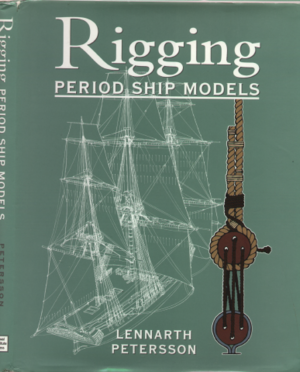
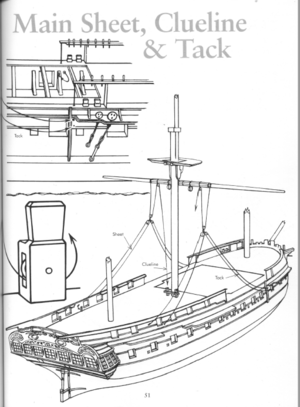
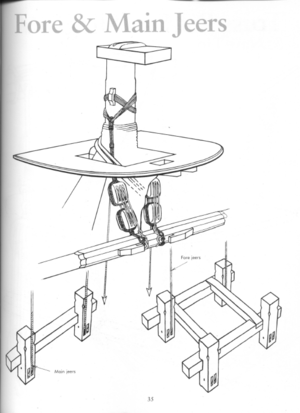
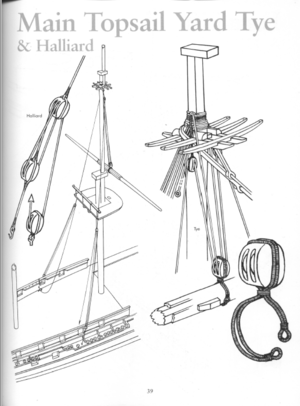
Whoops. . . look like I posted a response too late again! I know you're asking which lines are the ones that pass through the sheave on the belaying posts and then belayed to the posts. Usually these are lines which have high loads, like halyards, which hold up the yardarms. The photo above shows the jeers and halyards.
Last edited:
I got side tracked. My great grandson came to visit. I thought I had posted this. The arrow is pointing at where the sheaves would be if I had remembered before I glued the rail on. Duhhh.
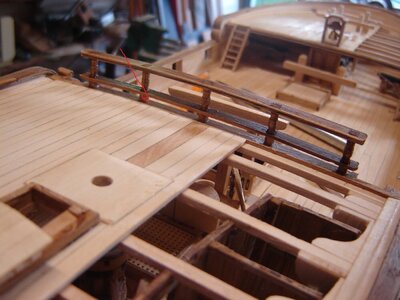
Anyway this is just an example of the difficulties I'm having when I try to find what goes where. Another example is the bitts although Kurt did show me where Peterson shows that. Maybe I'm just overwhelmed with the prospect of rigging. I'll see how Andersen's book looks.

Anyway this is just an example of the difficulties I'm having when I try to find what goes where. Another example is the bitts although Kurt did show me where Peterson shows that. Maybe I'm just overwhelmed with the prospect of rigging. I'll see how Andersen's book looks.
Don't be too dismayed when you learn that some of the parts have to be installed by guesswork based on and example from some other ship, or learn that you have to make guesses at where several of the running rigging lines are going to be belayed. There is far more guesswork based on research sources outside the scope of your model than most beginning modelers think. You have to pull tiny hints and bits of data from books, and hope that the examples from other models were not wild guesses themselves. Information like where you belay a specific line is where you find it... or perhaps not. A person who cannot accept that and forge ahead is in the wrong hobby.I got side tracked. My great grandson came to visit. I thought I had posted this. The arrow is pointing at where the sheaves would be if I had remembered before I glued the rail on. Duhhh.
View attachment 327654
Anyway this is just an example of the difficulties I'm having when I try to find what goes where. Another example is the bitts although Kurt did show me where Peterson shows that. Maybe I'm just overwhelmed with the prospect of rigging. I'll see how Andersen's book looks.
Last edited:
Sometimes you need to use guesswork. Deciding where running rigging is best belayed is not always a hard and fast rule of “this line from there always goes here.” When in doubt and in need of a belay point the one rule you should follow is to run a line as straight, clear, and clean as possible from the point of origin through an available sheave to a belay pin or bitt. One other thought…not every sheave or belay pin or bitt was always used. Many sheaves were added in case they were needed for temporary rigging. Such a case would be all of those sheaves in the base of stanchions…just because they were there does not mean they were always used…
Last edited:
1. A sheet from one of the lowest sails or perhaps a sheet from one of the T'gallants usually goes through these inset blocks.This is a question about where to find information. This is just one example of what I feel I'm running into. I'm building the quarterdeck breastworks. Each stanchion has two sheaves at it's base. What I'm wondering about is how do I find out what rigging goes through those sheaves. I have "Rigging Period Models" Steel's Rigging treatise(can't remember the name) and for the life of me I can't find a picture or text showing any rigging going through those sheaves. I'm sure that once I know what that bit of rigging is called I will be able to find a bunch of stuff about it but this is kind of a "Catch 22". I don't know what it's called so I can't look it up to find out what it's called. I need something that will kind of open a door through the initial confusion. Right now it's just a huge blank wall. Can anyone identify a source or method that may help me break into this. I'm not actually rigging yet but it's looming up and it's starting to wear on me. Thanks
2. Exactly which sheet goes where depends upon a host of details (perhaps unique) about how each individual ship was rigged.
I don't know of any hard-and-fast rules. The captain was the deciding voice in all matters of this nature. Sometimes they made
novel decisions. Your best bet might be to do a literature (include paintings) search and draw up some sample rigs and compare them to the plans you have. This is one of the other sides of model building that is not usually discussed.
3. One approach is to analyze the 'mechanics' of the lines and blocks required to run the ship. Run the lines in the most obvious direction for the most mechanical advantage, least amount of friction on the line/blocks, least amount of wear and tear on the rope itself and least amount of effort from the crew. You do this and you will be close to the reality of the times.
4. Sailors were non-educated (ignorant) and illiterate (that does not mean stupid and dumb). Of necessity, their approach to problem solving was simply to find a solution that would work for minimal expenditure of time, energy and money. Try it! The technique still works.

